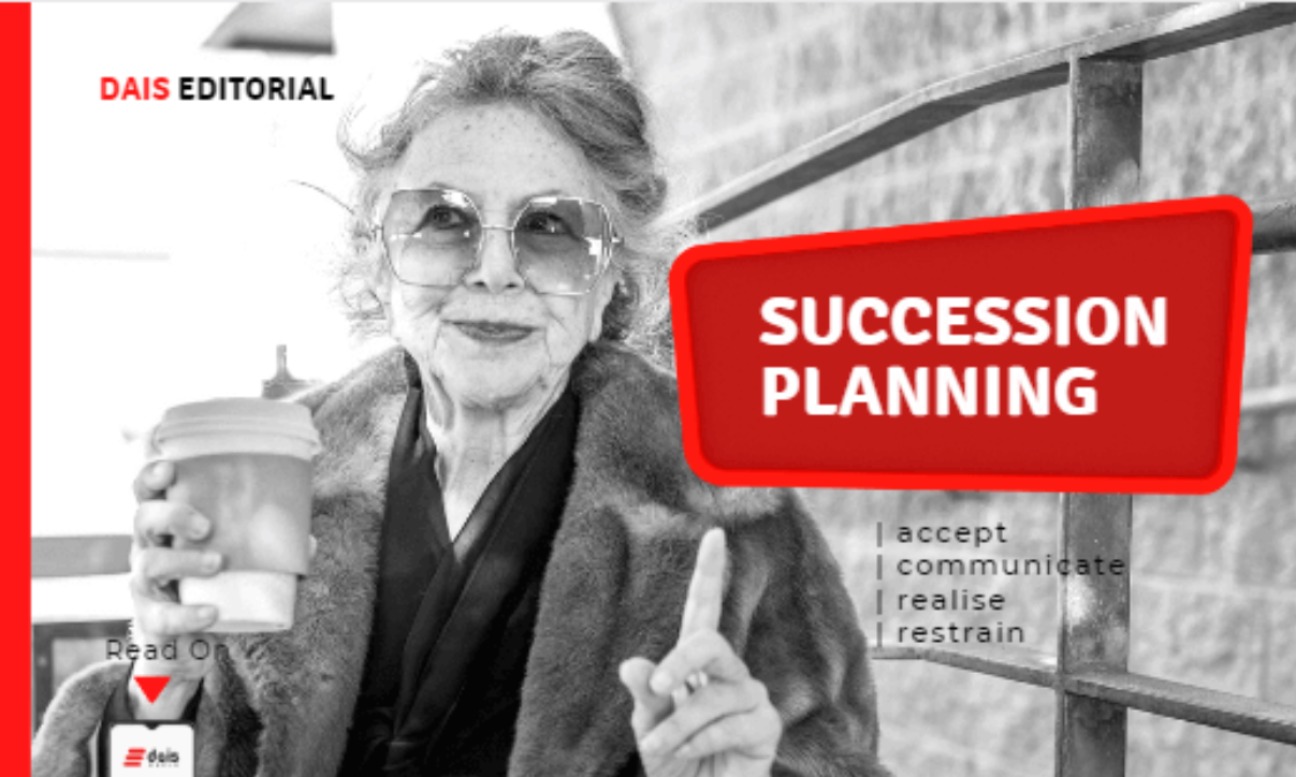Editorial > Want to Live after Death? Do your Succession Planning right
Want to Live after Death? Do your Succession Planning right

Dais Features | 19/05/2021 11:00 AM
A flourishing family business built carefully over time. Check.
Rightful successor in place to carry forward the baton identified. Check.
The family heir arms himself/ herself with a Master’s degree in Business from a prestigious university. Check.
The deserving heir also gains sufficient real-time work experience from a reputed firm before joining the family business. Check.
Classic textbook rules followed — all done just right. Nothing could possibly go wrong? Nothing!
Are you sure?
Because in most cases, that’s EXACTLY where the mistake lies…
The problem lies in the assumption that Succession Planning is all about Power Transfer — from one generation to the other, one Current-CEO to the oncoming CEO.
And heck if you care, if all your money has been earned by means of skilfully climbing up the corporate ladder yourself — no inherited fortunes per se — or even better, by just planning your finances and executing your investments diligently throughout your life.
You don’t even NEED Succession Planning — Right?
Again, Wrong.
Stereotyping a bespoke process like Succession Planning and Inheritance Management is the most obvious yet oft-repeated mistake families make, across generations — thus throwing away decades of toil on the passing of the Wealth creator.

In our second endeavour of traversing the wide-wild-world of Money Management after a very successful Feature of Women Manage Households and not Money with our experienced and knowledgeable partner, Harsha Vardhana V M, Founder and Managing Director of Atom Privé Wealth Management — we shake up the basic root of the Family Tree :
If your heirs don’t reap the benefits of what you have worked hard for, all your life — then what purpose do those hours away from family and personal comfort serve? You’d rather retire now because you have made enough to last your prudent needs for your lifetime.
But if you won’t, we urge you to read this eye-opening feature where we focus on some pointed and practical steps of getting this process right — here’s a start.
Step 1: Accept — A family is a complex entity
Imagine your dinner table — with your parents, your wife, your children, their children, your brother, his wife, their children, your loyal servants, your college principal, an old-time friend, all sitting together for a meal.
Does this make you happy? Great.
Does it also make you nervous? Thought so.
There are so many symbiotic factors that influence decision-making when a diverse set of people are involved, even if they belong to the same family. And when sometimes, non-blood relatives are involved in the picture — it becomes even more challenging to understand and propel forward.
Every individual comes with his/her own ideas, suggestions, inclinations and of course, expectations. Accepting that your family is no different than others’ and understanding their dynamics is the first step toward initiating the process of succession planning.



Take a pen and paper and begin filling in this checklist:
a. When you are no more, will it be the first time that a transition will happen in your family post coming into wealth and/or starting out a business? If not, what was the outcome of the previous transition? Did you get over the effects of that as a family? Has that ruptured relationships with any of your family members now?
b. Who, to your mind, is most capable of replacing you when you are gone — in the family structure as well on the business side — these can be two separate people.
c. Does the family perceive this person or two people as eligible to replace you as much as you do? If not, how divergent are they from your views and on what ground? Are they influential enough to affect the compliant members’ thoughts?
Acceptance is often the most logical step, but also often the most neglected one — and it often bases itself on the assumption that eventually, all will fall into place. Except, that it does not — not on its own. The best approach is to find a way to benefit out of the diversity of your family — understand its dynamics, play on its positives and iron out its chinks.
Step 2: Communicate — Through your living words, not your dead will
People who build wealth often forget or bypass the important skill of communication — not at their work nor with their employees — with their family members. And so, they leave all communication to be done in Nomination forms and Will documents — if at all.
They feel it will open a Pandora’s box that rather remains shut till they die. Some of us in Wealth Management call it Ultimate Levels of Escapism. You need to understand that you are the only one who has the power to decide your rightful inheritors and the only one that can communicate to everyone in the family about this decision — while you are alive. It is this lacuna that parents always leave behind, that keeps children fighting out of Family Courts for decades. So, unless you want your wealth to get transferred to the lawyers’ pockets instead of your children, the time to act is NOW.
While you are around, you will be able to better groom and shape up the incoming heirs and dispel their doubts and differences of opinion — bringing in a touch of experience to their youthful dynamism early on in their careers. They will learn only from you, why certain traditions exist in the business and the family, what ethos do these entities run on and how one could keep reinventing the colour of the business without impacting its core fabric- the culture.
And consider this — Playing to the strengths of the successors and using that as a guide to plan for leadership, can sometimes benefit the business in real-time.
Let tradition be their guide. Not dictator.
Step 3: Realize –All the talent in the world was not born to you
We all love our children and we all believe they are the best. No doubt about that. But do you honestly believe that your kid is capable of doing everything — excelling at school, doing great at sport, making on-point decisions every time, being an inspiring leader, functioning as an efficient team player, communicating ideas effectively every time, being a people’s person… etc, etc.
Be a realist. No! Right?!!
Your successor needs a support system — a group of individuals and/or professionals who can help him/her do everything, or most things, right from the word go. Appointing an advisory panel or strengthening your current board with trusted constituents whose qualifications go beyond just being blood relatives or friends, will go a long way in substituting your experience right away; without your successor having to go through costly trials and errors to reach your point of precision. Tax advisors, Wealth Managers, Family office consultants, Legal experts, Senior company executives often form a part of this Trusted and Empowered Group.
The Art of Letting Go, is an Art indeed!
The same applies to the home structure — expand the circle of influence beyond the immediate family circle. Gradually decentralize the decision-making processes there too — so that your successors learn to navigate the tricky paths of family management early on, under your watchful eyes.
Step 4: Restrain — Over excitement could scare them away
The idea of empowering the ‘right’ heir with a succession commitment might be a matter of great pride and reassurance to the current family head, but it’s best to refrain from making such commitments at an early stage. Continuous communication and careful planning are key to easing the identified ‘successor(s)’ into the role.
One must remember that the generation that is taking over may not have the same hunger that the prior head who started out from scratch may have had. Instead, they may have completely different approaches, and their motivations in life could be vastly different too.
Many a time, the identified successors face a lot of pressure and expectations to live up to, making them averse to the whole process, much before they take over. There are also instances when other talented and better-suited members of the family or even outsiders are overlooked to take on that role when commitments are made at an early stage.
It’s best to engage in constant communication with everyone involved and create a shared view of the future. This helps in driving commitment from both the generations involved and smoothens the process of handover.
Overwhelming though it may seem, the nature of succession planning, whether in the family or for a business is a necessary process — necessary because the construct of these institutions is infinite, unlike ordinary mortals like us. The sooner we understand this and adapt, the better.
While it may seem like a once in a lifetime process for you and may sound complicated in so many ways that even the thought of getting to it gives you the shudders, there are experts and professionals out there who are qualified to handle and help you with these situations — one just has to ask.
It is possible that it may not be one organization or one professional that would be able to formulate a solution for you — although with life, wealth and family structures getting more complicated by the day these services are fast-moving under consolidated roofs — you could always begin by asking your Tax Advisor, your Wealth Manager and your Legal Expert to form a first-cut solution tailor-made for you from their perspective.
This not only will give you a starting point but will also tackle the second question first — how feasible your thoughts are from a legal, financial and of course a taxation angle, eliminating the non-feasible ones even before you have developed on those thoughts.
Once this team of advisors and trusted individuals is in place, create a 7-step action plan for yourself and your heirs:
1. Identify the types of plans you are looking to draw out:
(1) Succession and transmission of assets to the next generation as the older generation passes away due to old age
(2) Succession and transmission of assets to the surviving partners/spouses and to the next generation as any family member passes away due to unforeseen circumstances e.g. an illness or accident. Covid has highlighted the need for such kinds of plans where younger, healthier members of the family have been lost and the family did not have a plan in place.
(3) Gradual transfer of assets during one’s lifetime to the next generation even while the older members are capable of controlling and directing the assets
(4) Handover of rights to make decisions on the family assets while the decision-maker is alive but is incapacitated to make decisions – e.g. in a coma or due to deteriorating mental health
2. Have your legal advisors, tax advisors and wealth managers put together a plan for each of the above sub-plans and then prepare a list of action items for you and the family.
3. Write down a list of help items that you will need from your family members and friends to execute your plan. Start contacting them and making them aware of the roles you have designated them to play when/in case any of the plans come to execution. For E.g. inform your best friend that you are appointing him as the executor on the will in case of something untoward happening to you and take his comfort of shouldering this responsibility.
4. Finalize the plans, draw out the documents and register them with the authorities – registered documents often accompanied by a ‘sound mind certificate’ from a recognized medical professional make them relatively Dispute-proof.
5. Once registered, handover one copy to the executor of the document (a person or a professional entity who will carry out your instructions as written out in the document when you are gone or incapacitated). Also store the original copy in the family document repository – a locker or a bank safe. Let the family and/or your trusted advisors know where to look for them in case of the incident.
6. Tell your wealth managers to synchronize all asset nominations and holding patterns with the documents so drawn out and registered- to avoid any disputes or confusion between family members.
7. Not all assets may be granularly covered in the documents mentioned above. Either hand them over to the inheritor while you are still capable of doing so or write down a Letter of Wishes and attach it to your documents – clearly mentioning who gets what when you are not there to distribute anymore. Remember this has to be very sparingly and only for assets that cannot be specified in a registered document – a good example of this being jewellery, art or personal effects like watches or collectibles.
We at Dais World are continuing our march towards making this Feature your go-to resource for everything you wanted to know about the Tough Journey of Making and Preserving Wealth but didn’t know whom to ask. We hope you enjoyed this read and drew out lessons to plan your family’s future better!
“There is no success without a successor” -John Maxwell


H a r s h a V a r d h a n a is the Founder and Managing Director of Atom Privé Wealth Management and the heart, brain, and thought behind this Feature.
Having been in the industry for over 19 years now, he wanted to incorporate the best of what the wealth management industry has to offer with the change he genuinely wanted to see in it.
Every client at Atom Privé is a growth partner and every approach is centered around what is most important to them. He therefore strongly believes in walking with them in their wealth journey by adopting the most holistic approach.
Dais World proudly partners with Atom Privé to guide its readers on the rewarding path of Money Management. Feel free to reach us at assist@dais.world to know more or tell us more and we would be delighted to experience the connect.
You were reading a Dais Editorial©2020
If you loved reading this Feature, comment on our social media handles and spread the word.








